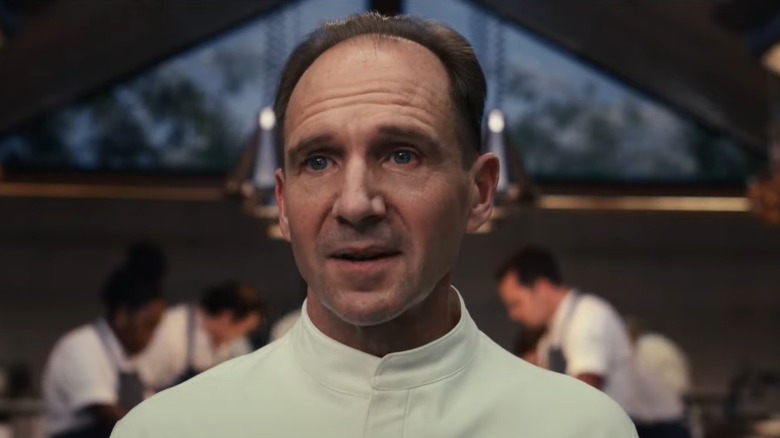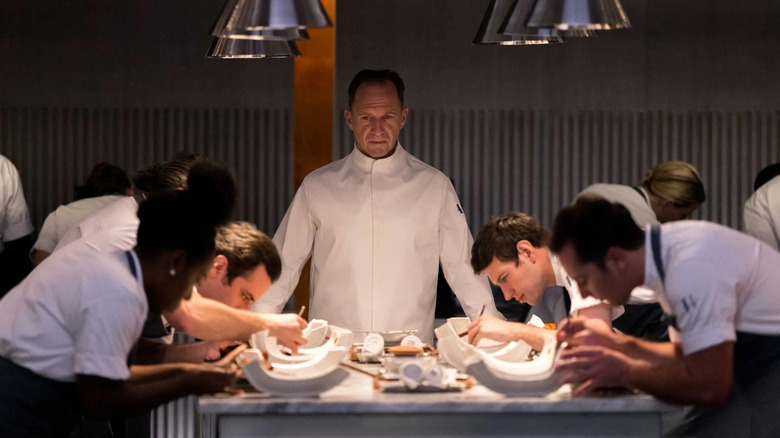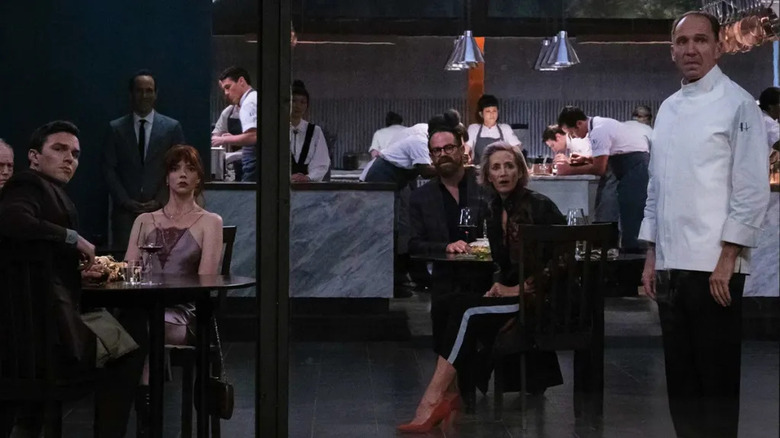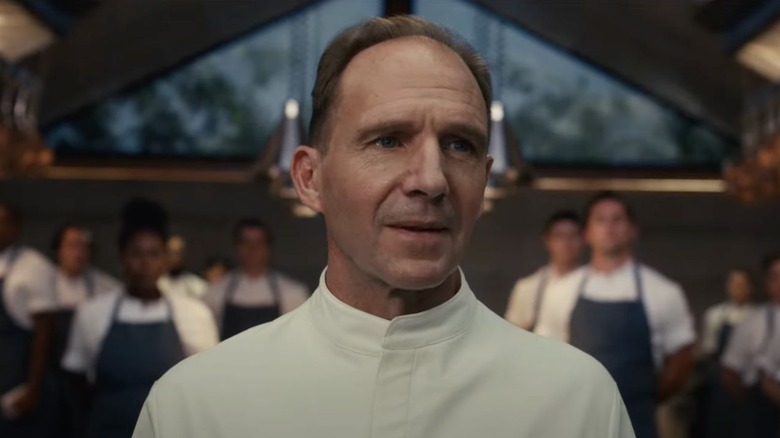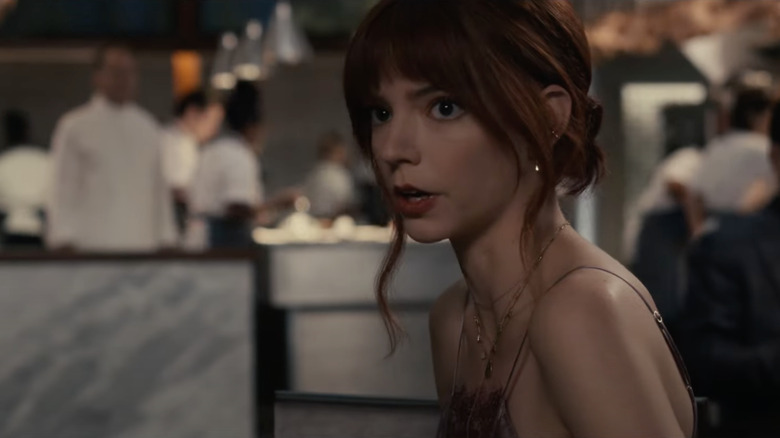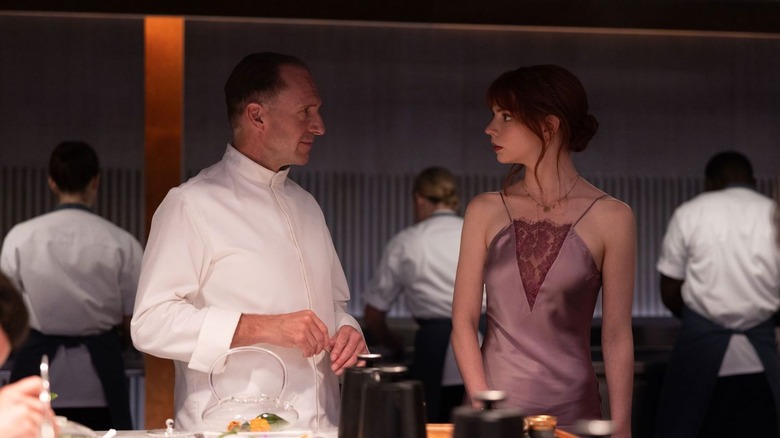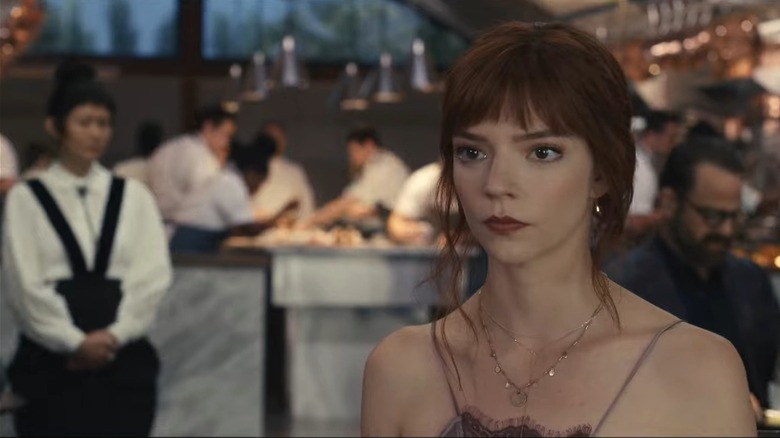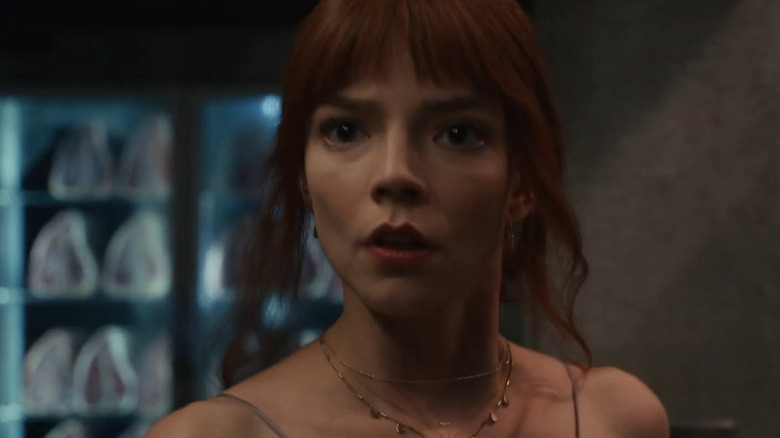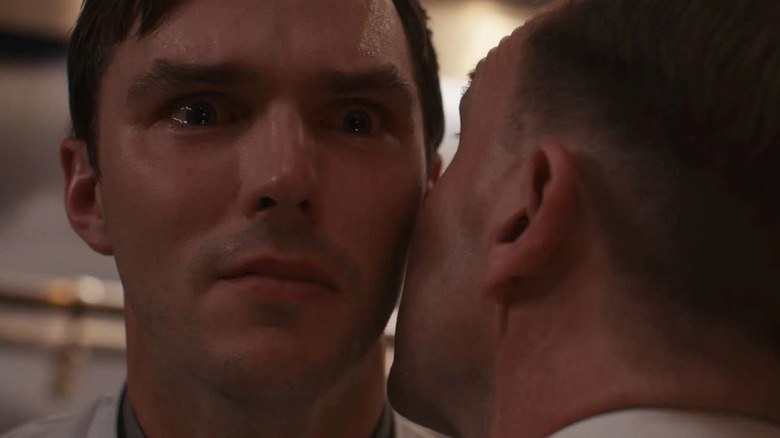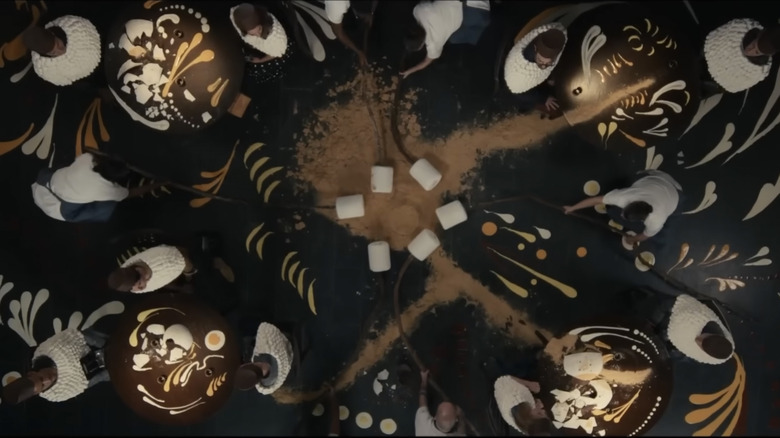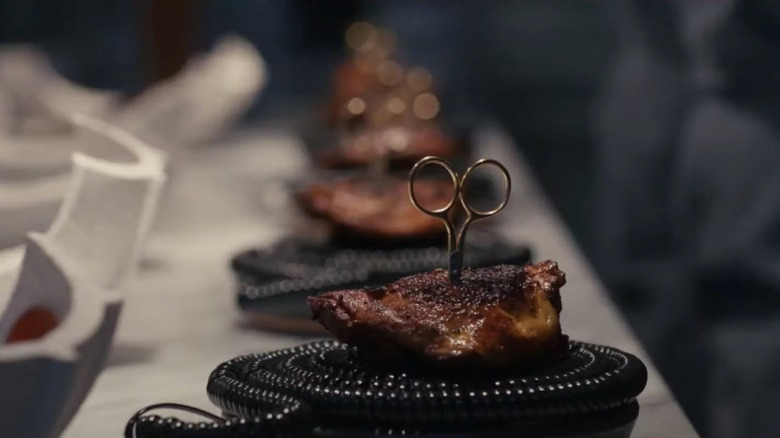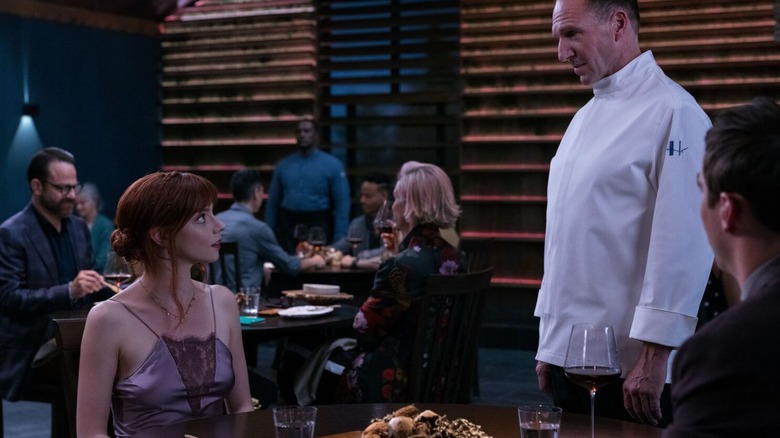The Ending Of The Menu Explained
Warning: This article contains spoilers for "The Menu."
Although Halloween might be long gone as we head into the holiday season, director Mark Mylod delivers some strong horror thrills that audiences can easily dine on with "The Menu." The film takes viewers into Hawthorne, a secluded island restaurant run by the renowned and hard-nosed Chef Julian Slowik (Ralph Fiennes) that specifically caters to the wealthiest clientele out there. This particular night at Hawthorne sees Chef Slowik and his loyal staff serve some incredibly wealthy clients as well as some snobby foodies, but Chef Slowik has a sinister twist up his sleeve: Unbeknownst to the guests, Chef Slowik has planned out a secretive menu for his guests that could be fatal if they're unable to turn the tables on him and his staff.
"The Menu" provides some great horror elegance and biting dark comedy with its very avant-garde atmosphere as well as some satirical jabs at high-class eating. As each course is served, the stakes raise immensely, and you are constantly left drifting closer to the edge of your seat. But, with all the wild aspects of Chef Slowik's menu coming to fruition and a sudden turn of fate for one of the guests, Margot (Anya Taylor-Joy), there are a lot of thematic story bits and sudden twists that could've slipped by. Well, have no fear, cause we're here to delve right into everything that was going on through the final few courses of "The Menu."
Inside Chef Julian's head
One of the biggest mysteries in "The Menu" is Chef Slowik since it seems like he's really going through a full-on breakdown throughout the night. Not only does he make a creepy early impression thanks to a disturbing tale of trauma from his childhood as well as Fiennes' incredible performance, but also he's been able to convince his staff to follow him to the end, literally. Now, with his newest group of guests, he's ready to end it all taking them, his staff, and even himself out in a ball of fire. So, why is Chef Slowik suddenly ready to end it all?
Well, he explains that after years of cooking overly artsy food for unworthy and disrespectful clients, he's completely lost his passion for cooking and now looks to end his suffering by dishing out some cold revenge. Chef Slowik's latest menu is simply him punishing those that have brought him into this life and embody everything he's grown to hate about the avant-garde food world, including petty food critics, narcissistic businessmen, and pretentious foodies. This disdain for "high-class culinary" perfectly explains Chef Slowik's generally cold presence and it's become so bad that he would rather not go on any longer than have to cook another meal ever again.
If you or anyone you know is having suicidal thoughts, please call the National Suicide Prevention Lifeline by dialing 988 or by calling 1-800-273-TALK (8255).
The overarching theme
Pretty early on, Tyler (Nicholas Hoult) explains that there's an overarching theme to Chef Slowik's meal that'll become clearer as the night goes on. So, what was that theme? Well, we know that Chef Slowik's motivations behind the menu are to punish the guests as they either played a physical or emotional role in his loss of love for food. And with him constantly telling stories about how he came to be this cold chef and how that's impacted his staff, it's safe to say that the overarching theme of the menu is Chef Slowik himself.
With each story behind the courses peeling back the layers of Chef Slowik, as well as his current style of culinary artistry, it starts to become clear that the general theme behind the courses is Chef Slowik's personal journey in losing himself over the years. We even get to see how Chef Slowik's rise to prominence has affected and impacted his staff in devastating ways, either making them realize that they'll never be as good as him or even facing his sexual advances. By the end, Chef Slowik even touches on the innocence he's lost with the final course, and his menu dishes out some cold reminders of how this avant-garde view of food has destroyed its essence for him.
Loyalists to the end
While it's clear why Chef Slowik is simply ready to end it all, since he'll at least get some cold revenge on his guests, it's a little tough to figure out why his staff is just so willing to follow him into the abyss. Most of them look pretty young and could have some promising cooking careers ahead of them with some of the engrossingly delicious-looking dishes they serve. So, why are they willing to go down in flames and never even think about fighting back? Well, the answer is because, sadly, there's no place they'd rather be.
It would be easy to say that Chef Slowik simply brainwashes the cooks to follow his order because of how in sync they are with him at every turn, but truthfully, they're more than willing to be there just so they can work for Chef Slowik. Chef Slowik's staff simply represents that allure that anyone can have wanting to make it in a tough industry and that willingness to do just about anything to attain the same accolades and respect as Chef Slowik. Sure, they might know that this will be their last meal cooked, but if they're working on Chef Slowik's masterpiece then it's an opportunity they can't pass up. It's basically the same reason that people don't quit after Gordon Ramsey screams and yells at them during service; their mentality in staying embodies their views of their art being more valued alongside Chef Slowik, even in death.
If you or anyone you know is having suicidal thoughts, please call the National Suicide Prevention Lifeline by dialing 988 or by calling 1-800-273-TALK (8255).
Margot's findings
Throughout the film, there's this silver door in a restaurant that catches the eyes and attention of Margot and adds another mystery to the whole ordeal. Once Margot is able to go into Chef Slowik's house while running an errand for him — and taking down his tough maître d' Elsa (Hong Chau) — she's able to see what's behind the same kind of door in his house. What she finds could be easily considered Chef Slowik's planning/motivation room since there are newspaper clippings on the walls of some of the reviews from Lillian (Janet McTeer) and photos that embody his rise to prominence.
However, Margot makes a more important discovery that gives her some inspiration for her survival. On a small table, she sees a photo of Chef Slowik working as a chef at a likely local burger joint smiling and looking like he truly has a passion for cooking. It might look unimportant to most, but Margot sees it as a symbol of Chef Slowik's love for food and a reminder of Chef Slowik's simpler life before becoming a world-famous culinary auteur. It's a moment that gives inspiration to Margot on how to finally get through to Chef Slowik and gives her the opportunity to survival.
Turning the tables on Chef Julian
Throughout the night, Chef Slowik tells Margot that these guests are being punished for influencing his falling out with food and for embodying this wealthy world of cooking that's devoid of any real love or compassion, but also that he sees her as different. Unlike the other guests, he somewhat respects her and believes that she is much more real than anyone else sitting in the dining room. Even with this respect, though, Chef Slowik doesn't plan to let Margot go, so she's forced to figure out some way to get him to let her leave.
Margot is able to find inspiration once she sees a photo of Chef Slowik cooking burgers in his youth while looking through his house and ultimately challenges him to make her a simple cheeseburger and fries. It's a moment that legitimately feels like a power shift as Margot does Chef Slowik's signature hand clap to get everyone's attention and looks totally in control as she's served a mouth-watering plate. By touching on that still-remaining desire to cook with his heart and make something simple with love, Margot is able to put Chef Slowik under her thumb and ultimately finds a way to escape off his revenge menu.
The cheeseburger
Margot's discovery of Chef Slowik's past as a burger chef is a major turning point in the film and heavily inspires her to order a cheeseburger in order to possibly save herself. Her request is granted, and Chef Slowik makes one hell of a plate of cheeseburger and fries that makes you want to rip it off the screen and eat it yourself. But is there something more to this cheeseburger than just being a cheeseburger? Well, kind of.
Not only does this cheeseburger connect to a former part of Chef Slowik's life as a chef who genuinely loved to cook food, but it symbolizes a part of cooking that's lost on most of the people in the room, including Chef Slowik. It represents that kind of easy cooking that's timeless and never needs to be anything flashy or fancy to be good or really establish a connection with people. It's innocent and has real flavor to it, not because of special spices but because the love and touch of the person cooking it feels present with every bite. We're not even talking about a fancy-style cheeseburger and fries or anything, just a nice simple burger sitting on top of a paper plate that easily puts a smile on your face. It certainly puts a smile on Chef Slowik's face and reignites this radiating love of food that had been gone for so long.
Allowed to leave
After getting Chef Slowik to fill her request for a cheeseburger, there's kind of this moment where you wonder if she'll actually get him to let her go. Even in her request to have the rest be taken to go, you can't help but question if it'll actually work, but surprisingly, it does. Chef Slowik wraps up all her food in a paper bag, gives her a party favor bag, and tells his staff to let her walk out the door and leave. So why does he have a change of heart with her?
Well, Chef Slowik constantly tells Margot that she's different from everyone else in the room that night because she comes off as more genuine and real than the others. So, with this whole cheeseburger ordeal, she fulfills Chef Slowik's idea of her and likely lets her go because he feels she doesn't deserve to die with the rest of the room. Or maybe he just respected how clever she was with that to-go request. Either way, Margot uses that love for food within Chef Slowik to make a last-ditch effort to survive, and it totally works.
No one else though?
Once Margot is allowed to leave, you're kind of left wondering if Chef Slowik is about to have a change of heart and maybe end the bloodshed that's consumed the night. After all, Chef Slowik was just reminded of his love of food and cooked a meal that brings some genuine warmth to the character for the first time in the film. However, once Margot leaves, he basically reverts back to his old form as the final course is ready to be served. So, why doesn't Margot's cheeseburger request change anything for Chef Slowik?
Chef Slowik doesn't have a real change of heart. He's still so committed to this menu, and just because Margot showed that she isn't like the others in the room, doesn't mean that it changes anything for anyone else in the room, including Chef Slowik. He always felt that Margot was different and once she's out of the line of fire, there's nothing stopping him from completing his masterpiece. Frankly, even the other guests kind of accept their fate as no one tries to stop Chef Slowik in the final moments, and Anne (Judith Light) even waves Margot to leave.
No hope for survival
Although Margot is able to escape by touching on Chef Slowik's past love for food, the other guests are basically trapped for the finale begging the question, is there any opportunity for them to really escape? Chef Slowik talks about them possibly being able to fight back and even allows the men to run and hide on the island during the "Men's Folly" course, but seriously, can they really escape?
The answer is likely no since the Hawthorne staff looks plenty fit to fight off any physical advances made by the guests. Margot even faces some stiff opposition from Elsa, and no one else is able to effectively hide from the staff during the little hide-and-seek match. Even if they try to play on Chef Slowik's humanity in the way that Margot has, Chef Slowik would probably see it as insincere and keep them captive. Throughout the film, the guests are told there's no escape for them, and that seems like the case right up to the bitter end.
A fiery final course
After all the bloodshed and horrors throughout the night, you're left wondering what Chef Slowik has up his sleeves for the final course that's likely going to be the last meal anyone here has. Like any classic auteur chef, he can't just do something simple and goes for an avant-garde take on s'mores. Why s'mores though? Well, he talks about how s'mores are the staple of any innocent childhood, curling up around the fire with family and friends roasting marshmallows.
So, this final course is likely meant to represent the innocence that was lost by Chef Slowik, himself, and instead of roasting marshmallows, the plan is to roast everyone inside Hawthorne. It's a visually stunning secret with the trio of ingredients for s'mores having an avant-garde look and everything and everyone going up in flames is a horrifying sight to behold, especially with all the guests covered in marshmallows. It's a fiery final course with some solid symbolism and horrifying conclusions.
Hawthorne turned to ash
With Chef Slowik's menu finally coming together and his final course in action, there's only one way for things to end: in flames. Just after saying his goodbyes and final words to his guests, Chef Slowik lights the room ablaze and puts an end to this night of horrors. With Margot's boat escape not going as planned since the boat breaks down for a moment, we see the final results of Chef Slowik's menu and what's left of Hawthorne.
As Margot looks behind her and back at Hawthorne, she can see flames bursting out of windows and the entire building starting to burn down meaning that Hawthorne is no more. The restaurant and possibly the entire island will simply turn to ash before anyone can save it, and Julian's vision of this artsy world of cooking coming to an end has been fully realized. It does present the perfect backdrop for Margot to simply keep eating her cheeseburger in peace knowing that she survived, but there's still a horrifying feel to it all.
If you or anyone you know is having suicidal thoughts, please call the National Suicide Prevention Lifeline by dialing 988 or by calling 1-800-273-TALK (8255).
Could there be a sequel?
As of the time of this writing, there is no announced sequel for "The Menu" in development, but, as always, it's worth questioning if there can be one. Unless, there's a plan to turn "The Menu" into some kind of anthology series that maybe could show a new set of guests dealing with a new chef looking to make a horror-filled menu, it's pretty safe to say there will be no follow-up film since things kind of end pretty definitively here.
Hawthorne is burned to the ground; Margot is the sole survivor getting to escape on the boat and enjoy her cheeseburger in peace; and Chef Slowik's legacy ends up being destroyed by his own masterpiece, with no real successor mentioned or hinted at. With everything that happens, the story of "The Menu" is closed and shut to present a one-off horror story full of decadent food, sharp comedy, and disturbing moments.
